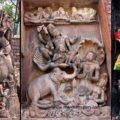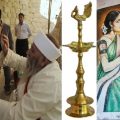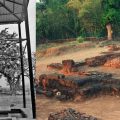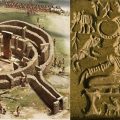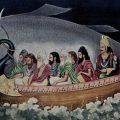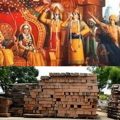Ancient Ganesha Moorti at Mount Bromo and Tenggerese Hindus; An Account
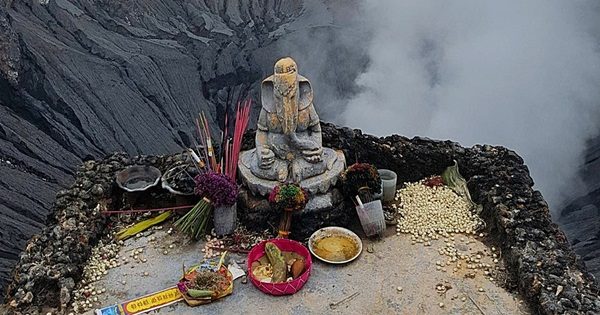
Ganesha in Mount Bromo! The phrase may sound familiar to few but unheard to many. Mount Bromo is an active volcanic site in East Java, Indonesia located at a height of 2,329 meters. A moorti of Ganesha adorns the top of this volcano mountain! Tenggerese Hindus have been worshipping Ganesha here since the last several hundred years. They believe that Bhagwan Ganesha is their protector. This site is part of the Bromo Tengger Semeru National Park, a sand sea conservation area.
The term Bromo is the Javanese pronunciation of Brahma, one of the Hindu Trinity. Ganesha and Brahma are evidences of Sanatana culture that widely flourished in this part of the world. And Ganesha adorns the currency note of Indonesia.
The active volcano site of Mount Bromo transports us to the Toba volcanic eruption that took place 75,000 years ago. One of the largest known volcanic eruptions that destroyed life spanning thousands of kilometers, it occurred at present Lake Toba in Sumatra. According to researchers, the volcanic event of Toba led to a global volcanic winter of nearly 10 years! Remains of Toba ash were discovered in layers during excavations at Jwalapuram in Andhra Pradesh. Thousands of artefacts were excavated from there, which date back from the Toba volcanic catastrophe, i.e. 75,000 years and beyond. If the Toba ash impacted a region in the southern part of India, we can well imagine the consequences of the volcano. Excavations in the future in other regions may further lead us to more evidences.

Jwalapuram excavations site where Toba volcano ash of Indonesia was discovered and artefacts
Mount Bromo, also called Tengger, is located in the middle of the ‘Sea of Sand’ reserve, being protected since 1919. There has been several episodes of eruption of the site. Time and again, warnings are issued against visiting the site depending upon the intensity of the volcanic activity. Warnings are issued by the Indonesian Center for Volcanology and Geological Hazard Mitigation.
According to a news report published in Dainik Bhaskar – as per their interaction with Ketut Donder from Indonesia, there are around three lakh Hindus residing in 48 villages in the Tengger region around Mount Bromo. They are Tenggerese Hindus, a Javanese ethnic group. They consider Ganesha in Mount Bromo as their protector. Various records justify the claim of the Tenggerese Hindus to be descendants of Majapahit princes Roro Anteng and Joko Seger. Details about the princes are described in James Minahan’s Ethnic Groups of South Asia and the Pacific: An Encyclopedia.
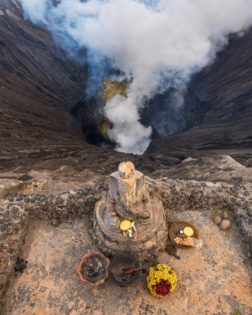
Ganesha in Mount Bromo; Image source/Courtesy: Reddit
Majapahit was a sea-borne Hindu-Buddhist empire that flourished in Java from 13th century. Historical Atlas of Indonesia by Robert Cribb and Desawarnana, an old Javanese eulogy dedicated to Majapahit Javanese king Hayam Wuruk, the Majapahit was an empire of 98 tributaries, stretching from Sumatra to New Guinea. James Minahan’s Ethnic Groups of South Asia and the Pacific: An Encyclopedia mentions an ‘estimated 675,000 Tenggerese speak the Majapahit or Tengger dialect, an archaic form of Javanese’. Tenggerese Hindus follow the Saka calendar system.
Before delving about the Hindu festival celebrated at the Tengger region and about Ganesha in Mount Bromo, let’s explore the historicity of the Tenggerese Hindus drawing lineage from Majapahit princes Roro Anteng and Joko Seger. To quote from James Minahan’s Ethnic Groups of South Asia and the Pacific: An Encyclopedia,
“Influenced by contact with ancient India, Hinduism and Buddhism spread through the island before the fourth century C.E. The first major principality arose in central Java at the beginning of the eighth century. Its religion, centered on the Hindu god Shiva, helped to spread Hinduism to the interior of the island…..Around the tenth century, the center of power in Java shifted from central to eastern Java, with the emergence of Hindu states. The most powerful, Majapahit, was established in the fourteenth century, claiming sovereignty over the islands of Java, Madura, and Bali. The Tenggerese were brought into the kingdom and embraced the state religion, Hinduism, without losing their earlier archaic Hindu rites and the Buddhist and animist traditions of the region.”
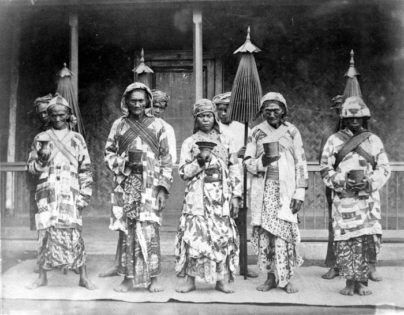
Tenggerese pujaris from 19th century; Image source/courtesy: Wikipedia
Islamic states began their expansion in western Java by the sixteenth century and majority of the Hindu population were driven out. Majapahit kingdom thus collapsed. The last Majapahit king Brawijaya had a daughter named Roro Anteng who was married to Joko Seger (also called Jake Seger), a Brahmin. To avoid persecution by the islamic rulers and forceful conversion to Islam, both Roro and Joko along with their followers fled eastwards. They sought refuge in the isolated Mount Bromo, i.e the Tengger region. To further quote James Minahan’s Ethnic Groups of South Asia and the Pacific: An Encyclopedia,
“Tengger became the last bastion of Majapahit and the Hindu religion on the island. Roro Anteing and Jake Seger ruled Tengger, becoming the ancestors of the Tenggerese people. The isolation of the region allowed the Tenggerese to retain their distinct culture and religion as Islam was embraced as a cultural and religious belief system by the peoples of Java in the seventeenth and eighteenth centuries.”
Tenggerese Hindus have been performing a ritual since several centuries and the tradition continues till today. It is the Yadnya Kasada (or Yajna Kasada), an offering made to the deities at the edge of of the crater on the top of Mount Bromo. Every year, this festival is held on the 14th day of the Kasada month of the traditional Tengger calendar corresponding to July. Fruits, flowers, food offerings, etc. are offered to the deities, which are dropped below into the crater. The ritual was first started by Roro Anteng and Joko Seger.
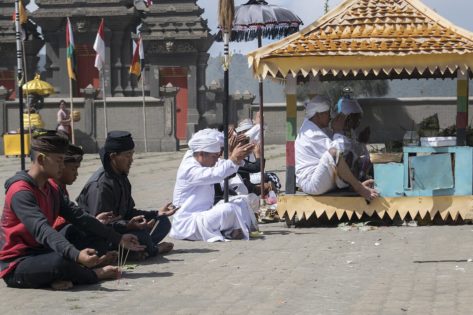
Rituals at base of Mount Bromo during Yadnya Kasada festival. Image source/courtesy: Shutterstock/indonesia.travel
There is an interesting story behind how the Yadnya Kasada festival started. The Tengger kingdom flourished under Roro and Joko, but they remained childless for many years. They both climbed to the top of the volcano and prayed to Sang Hyang Widhi – the Supreme God, also called Acintya. Bali: A Traveller’s Companion by Irene Toh, Juliette Morillot and Debbi Guthrie-Haer identifies Sang Hyang Widhi with Suryadev, the Sun God. Their prayers were heard and they begot children. Roro and Joko made offerings to the deity from an edge at the top of the volcano. Since then offering rituals have been followed by the Tenggerese Hindus.
Other key deities worshipped along with Sang Hyang Widhi are Ganesha and the Trinity – Mahadev, Brahma, and Vishnu. During the Yadnya Kasada festival, devotees generally start their procession from Ngadisari village and pray at the Luhur Poten temple (dedicated to the deities mentioned above), located at the bottom base of the sand grounds of Mount Bromo. They pray for their prosperity and safety. They also offer prayers to their ancestors including Roro Anteing and Jake Seger.
To quote Current Triggers, “Yajna Kasada is not only an expression of gratitude to God’s love for His grace but also a moment for remembering and honoring the sacrifices of their ancestors, Roro Anteng and Joko Seger, who undertook hardships to preserve the dharma and the lives of the present-day Tengger ethnic minorities.”
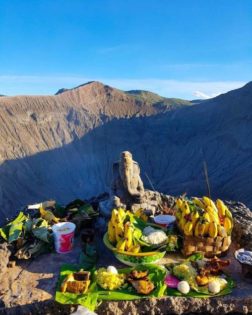
Offerings to Ganesha at Mount Bromo; Image courtesy/source: Hindu Cosmos
The annual Yadnya Kasada festival is celebrated for about a month. On the 14th day, the Tenggerese Hindus assemble at the Luhur Poten temple, seek blessings from the deities and then proceed towards the top of Mount Bromo for the offering ceremony. Both the Luhur Poten temple including Moortis of deities and the ancient Ganesha Moorti located on the top of Mount Bromo have been created using natural black stones from the volcanoes. The temple and the Moorti of Ganesha date back to several centuries.
According to a report by Dainik Bhaskar during the volcanic eruption of Mount Bromo in 2016, the Indonesian govt. allowed 15 pujaris to perform the puja rituals at Mount Bromo. But Tenggerese Hindus turned up in thousands to offer prayers to Ganesha, seeking protection. The devotees in that region believe that not offering prayers would only bring destruction.
May the Tenggerese tribe increase and may this ethnic Hindu community stay safe!
Ref:
1. Ethnic Groups of South Asia and the Pacific: An Encyclopedia by James Minahan.
2. Bali: A Traveller’s Companion by Irene Toh, Juliette Morillot and Debbi Guthrie-Haer.
Featured image courtesy: 88milestones.

